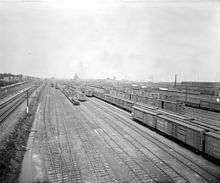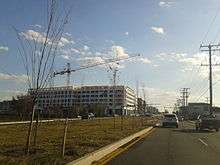Potomac Yard

Potomac Yard was one of the busiest rail yards on the Eastern Seaboard of the United States. Today, it refers to the neighborhood encompassing the same, which straddles southeastern Arlington County and northern Alexandria, Virginia, bounded by U.S. Route 1, the George Washington Memorial Parkway, Four Mile Run, and Braddock Road. It may also refer to one of several developments on the site, especially the Potomac Yard Retail Center strip mall.
History
English settlers built several plantations on the site in the 18th century.[1]:103–4 The land, much owned by the Swann and Daingerfield families, became part of Alexandria County, D.C. with the creation of the District of Columbia in 1791, and retroceded to Virginia in 1846.
Its role as a transportation hub began when Congress chartered the Alexandria Canal Company in 1830. The canal, which opened on December 2, 1843, would connect the port of Alexandria with the end of the Chesapeake and Ohio Canal (completed 1850) in Georgetown via the Potomac Aqueduct Bridge. It would operate until abandoned in 1886.[1]:105–6

Railroad development in the area began in the 1850s, though stymied by political concerns and by the American Civil War. The Alexandria and Washington Railroad began service on a new rail line between Long Bridge and Alexandria in 1857.[1]:106 Order to the region's mishmash of active and abandoned rail lines and stations did not come until the City Beautiful movement of the late 19th century. The 1901 Plan for Washington, D.C. (report of the McMillan Commission) proposed consolidating the region's rail operations, including a new Washington Union Station (approved 1903, completed 1908) and a New Long Railroad Bridge (completed 1904).[2]
In accordance with the plan, the Pennsylvania Railroad (PRR), Baltimore and Ohio Railroad, Southern Railway, Chesapeake and Ohio Railway, Atlantic Coast Line Railroad, and Seaboard Air Line Railway formed the Richmond-Washington Company to manage traffic. This holding company controlled the Richmond, Fredericksburg and Potomac Railroad (RF&P), the new Alexandria Union Station, which opened in 1905, and the new switching yard—Potomac Yard—which opened on October 15, 1906.[3]
The booming "Pot Yard" attracted thousands of workers, who largely settled in the areas of Del Ray and St. Elmo. These subdivisions incorporated as the town of Potomac in 1908, but were annexed by the City of Alexandria in 1930.
Potomac Yard in its heyday was one of the busiest railyards in the Eastern United States, processing thousands of cars daily. The PRR extended its railway electrification program to Potomac Yard in 1935, marking its southernmost point.[2] The Penn Central segment of the famous Tropicana Juice Train operated from here. The site reached capacity in 1937.
After the corporate mergers of the former separate railroad companies that used the yard to interchange freight cars, the need for Potomac Yard greatly diminished. It was determined by the RF&P that the land was worth more than the need for yard switching. The PRR's old catenary was dismantled in the 1980s. The facility was identified as a toxic waste site in 1987. The RF&P finally decommissioned it in 1989. Plans for rehabilitation and redevelopment of the land have been a source of intense debate since then.
Redevelopment


At decommissioning, decades of industrial use had left the site contaminated with heavy metals and hydrocarbons, including diesel fuel. It was immediately declared a Superfund site. In 1995 the Environmental Protection Agency (EPA) approved RF&P's study and cleanup plan, and cleanup was declared completed by 1998.[4]
Various commercial and community interest groups came into conflict over the future of the brownfield land. The City of Alexandria rejected the original mixed-use plan in 1992. Jack Kent Cooke, owner of the Washington Redskins, unsuccessfully pushed for the construction of a new football stadium on the site. Seventy of the 400 acres (1.6 km²) of the site were approved for retail use in 1995; the Potomac Yard Center, a 589,856-square-foot (54,799.4 m2) strip mall anchored by big box stores, was completed in 1997. Other sections of Potomac Yard have since been slated for development as residential units, office space, parkland, and retail use. The Potomac Yard Complex by Crescent Resources is already under construction. One and Two Potomac Center was completed in November 2005 and houses several EPA offices. The southernmost portion of the Alexandria section is under construction as of August 2006. It includes two plans, one for Arlington and one for Alexandria. The Alexandria portion of the site is highlighted by a new Town Center. The plan also includes 1,900,000 square feet (180,000 m2) of office space; a 625-room hotel; 135,000 square feet (12,500 m2) of neighborhood retail space; and approximately 1,900 residential units. The plan for the Arlington site includes 2,800,000 square feet (260,000 m2) of office space; a 625-room hotel; 100,000 square feet (9,300 m2) of neighborhood retail space; and approximately 1000 residential units. The plan also calls for a 25-acre (100,000 m2) park, which will be owned by Arlington County.
Potomac Yard Park
Construction for Potomac Yard Park began in 2009, and it opened on December 14, 2013. The park contains a water fountain, playgrounds, and sports fields within 24 acres. Located south of the main shopping district, it borders train tracks carrying freight and Virginia Railway Express commuter rail.[5]
Transportation
Bus rapid transit from Crystal City to Potomac Yard opened in August 2014. Branded as Metroway, it travels in dedicated lanes along U.S. Route 1.
Planning for a Washington Metro infill station is under way, with an estimated opening in 2020.[6]
A streetcar system in Northern Virginia was proposed to open in 2020, with trains traveling between Potomac Yards, Crystal City, Pentagon City, and Bailey's Crossroads.[7] In late November 2014 the County Board cancelled the streetcar plan.[8]
References
- 1 2 3 Bromberg, Francine W. (2010). "The History of Potomac Yard: A Transportation Corridor through Time." Appendix III of North Potomac Yard Small Area Plan. City of Alexandria, VA.
- 1 2 Cohen, Robert (2003). "History of the Long Railroad Bridge Crossing Across the Potomac River." National Railway Historical Society, Washington, D.C. Chapter.
- ↑ National Railway Historical Society, Washington, D.C. Chapter. "Timeline of Washington, D.C. Railroad History." Accessed 2012-11-14.
- ↑ U.S. Environmental Protection Agency, Philadelphia, PA. "Mid-Atlantic Superfund: Potomac Yard." Accessed 2012-11-14.
- ↑ Hansen, Drew. "Curtain Goes Up on Potomac Yard Park". Patch.com. Retrieved 15 October 2014.
- ↑ Lazo, Luz (June 14, 2016). "After delays, plan to build Potomac Yard Metro station project moves forward". The Washington Post. Retrieved 21 July 2016.
- ↑ Trompeter, Brian (October 9, 2014). "Fairfax supervisors OK next steps toward Columbia Pike streetcar project". InsideNoVa. Retrieved 15 October 2014.
- ↑ Sullivan, Patricia (November 18, 2014). "Arlington officials halt efforts on streetcars for Columbia Pike, Crystal City". Washington Post. Retrieved 18 November 2014.
- Hammer, Ben. "Potomac Yard sale could alter mix," Washington Business Journal, May 21, 2004.
- City of Alexandria, VA. "Potomac Yard Development."
External links
- City of Alexandria: Potomac Yard/Potomac Greens Small Area Plan (PDF), Adopted 1992 Master Plan.
- McCaffery Interests: Potomac Yard Retail Center
- Comstock Communities: The Eclipse at Potomac Yard
- Potomac Yard Development LLC:
- Lynhaven Citizens Association (Alexandria, VA)
- Richmond, Fredericksburg & Potomac Railroad Historical Society